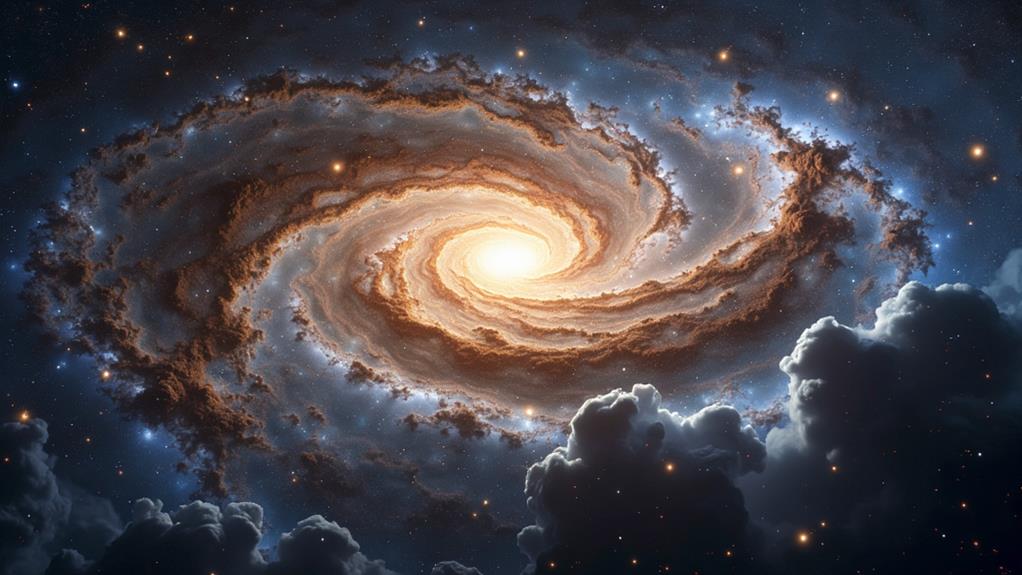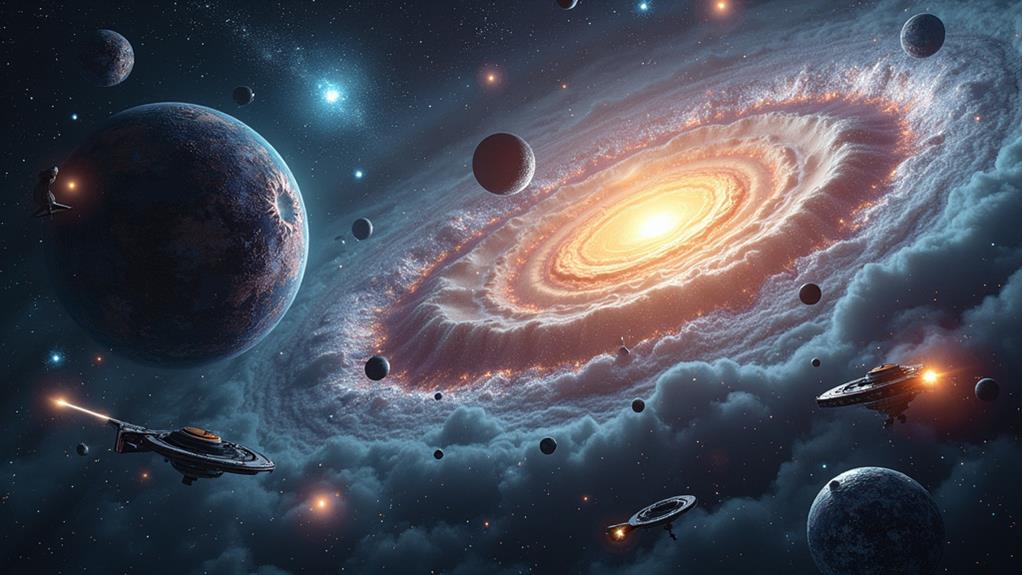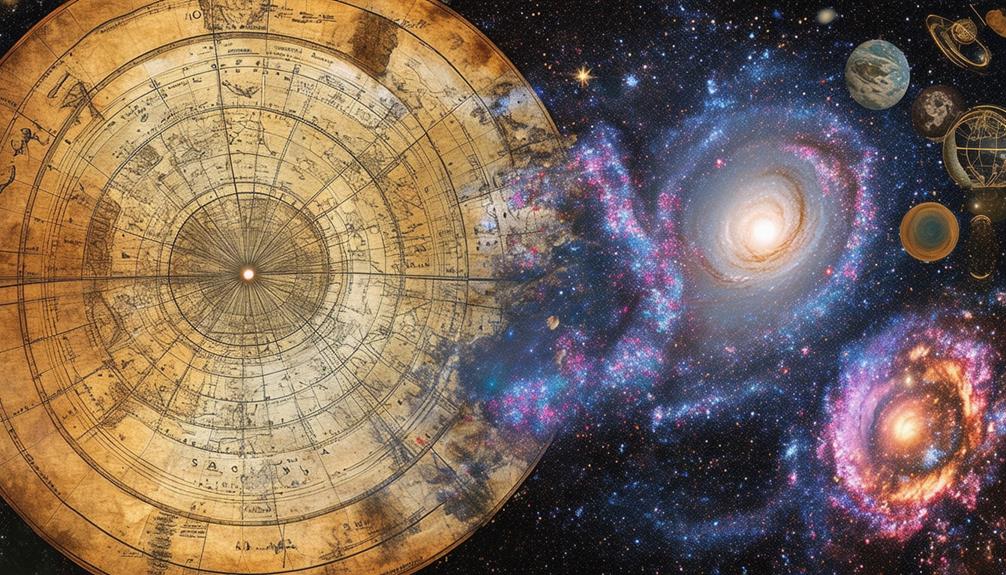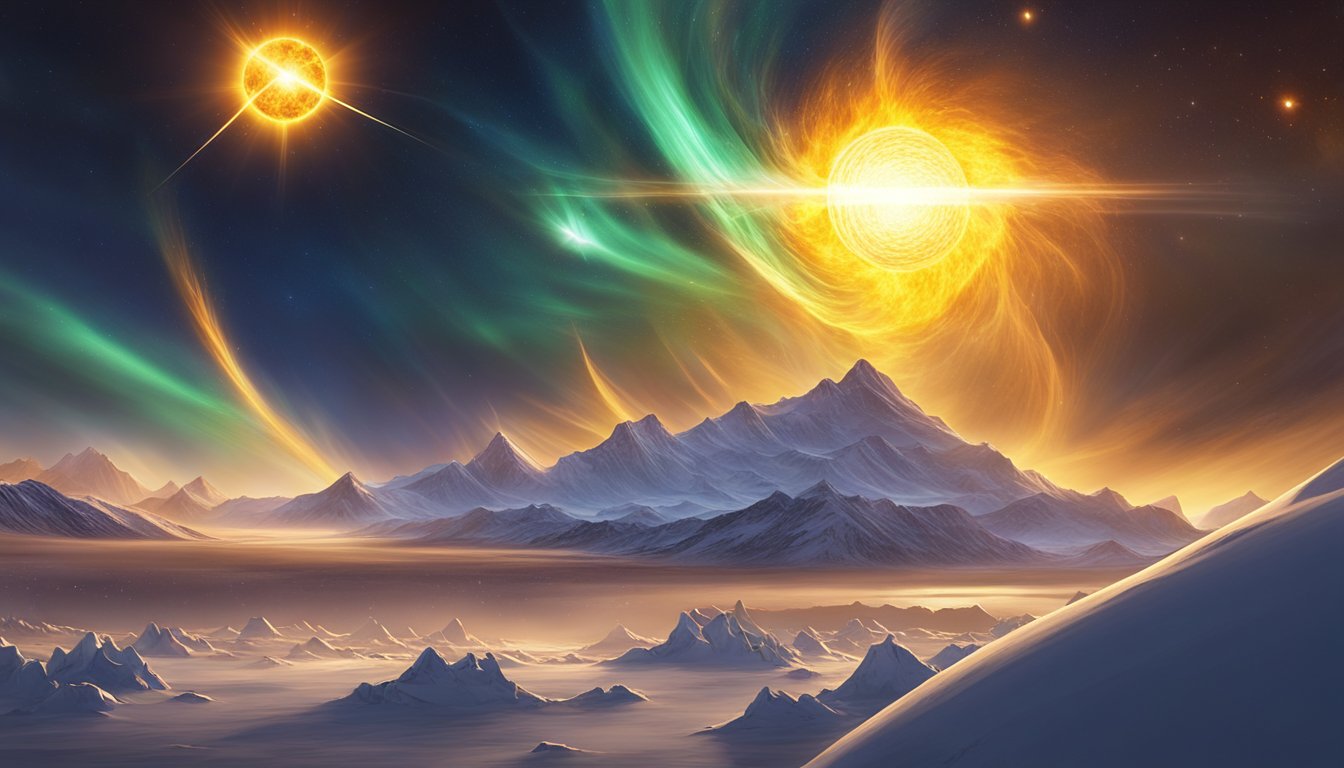Why Do Dark Matter Effects Shape Galaxies?

You can't fully understand the shape and structure of galaxies without recognizing the crucial role dark matter plays. It doesn't emit, absorb, or reflect light, making it invisible, yet it makes up about 27% of the universe's mass-energy content. Dark matter forms halos around galaxies, influencing their gravitational dynamics and preventing disintegration. It affects rotational speeds and allows normal matter to cluster, initiating star formation. The presence of dark matter is also confirmed by phenomena like gravitational lensing and galaxy rotation curves. Want to grasp the universe's hidden scaffolding? Let's investigate further.
Key Takeaways
- Dark matter's gravitational pull attracts normal matter, aiding in galaxy formation and structure.
- It forms halos around galaxies, providing the necessary gravitational glue to prevent them from disintegrating.
- Galaxy rotation curves reveal dark matter's presence through higher-than-expected outer region speeds.
- Gravitational lensing by dark matter distorts light, indicating its influence on galaxy mass distribution.
- Dark matter scaffolding enables gas cooling and condensation, crucial for star formation within galaxies.
Dark Matter Overview
Even though we can't see it, dark matter makes up about 27% of the universe's mass-energy content. You won't find it emitting, absorbing, or reflecting light, making it invisible to our detection methods. Despite this, dark matter is vital for the structure of the Universe, especially regarding galaxies.
Dark matter's gravitational effects are fundamental for maintaining the integrity of galaxies. Without it, galaxies would disintegrate. This unseen mass typically forms a halo around the observable matter in galaxies, greatly influencing their gravitational dynamics.
One of the most compelling pieces of evidence for dark matter comes from observing galaxy rotation curves. Stars in the outer regions of galaxies rotate at speeds much higher than expected based on the visible mass alone. This discrepancy points to the presence of dark matter extending beyond the luminous parts of galaxies.
The distribution of dark matter is generally pseudo-spherical and extends far beyond the visible components. This has profound implications for the formation and evolution of galaxies. It's clear that dark matter isn't just a small part of the cosmos; it plays a critical role in shaping the Universe as we understand it.
Evidence Supporting Dark Matter
A wealth of evidence supports the existence of dark matter, starting with galaxy rotation curves. When you look at spiral galaxies, you'll notice that their outer regions rotate much faster than expected. This anomaly suggests an unseen mass, a dark matter halo, exerting a gravitational influence to keep these regions from flying apart.
Gravitational lensing offers another compelling piece of evidence. When light from distant galaxies gets distorted by massive galaxy clusters, the visible mass alone can't explain the lensing effects. Dark matter's gravitational pull accounts for this discrepancy, reinforcing its existence.
Then there's the Cosmic Microwave Background (CMB) radiation. Observations of the CMB reveal fluctuations that align perfectly with models where dark matter plays an essential role in structure formation throughout the universe's history. This shows dark matter's influence from the universe's earliest moments.
Large-scale structure surveys further support dark matter's role. These surveys reveal that galaxies aren't randomly scattered but instead form intricate, filamentary patterns shaped by dark matter's gravitational forces.
Lastly, dwarf galaxies show high dark matter-to-stellar mass ratios, highlighting dark matter's considerable contribution to their formation and stability. All this evidence collectively strengthens the case for dark matter shaping the cosmos.
Role in Galaxy Formation

Dark matter's crucial role in galaxy formation can't be overstated. When the universe was expanding after the Big Bang, dark matter's gravitational influence began to shape the cosmos. Even though you can't see dark matter, it accounts for about 27% of the universe's mass-energy content, providing the gravitational pull that holds galaxies together. Without dark matter, the formation of galaxies as we understand them wouldn't have been possible.
Dark matter halos envelop galaxies, creating regions where gas can cool and condense, leading to star formation. This interaction between dark matter and baryonic matter—like stars and gas—creates the structures we observe in the night sky. The gravitational effects of dark matter guarantee that the outer regions of spiral galaxies rotate faster than you would expect based on visible matter alone, highlighting its pivotal role in galaxy dynamics.
Simulations show that dark matter's influence is vital for clustering normal matter into the galaxies we see today. In essence, dark matter acts as the scaffold upon which the visible matter is built, forming the intricate structures and types of galaxies that populate the universe. Without it, the energy required for galaxy formation and stability wouldn't be sufficient.
Galactic Structure Influences
The influence of dark matter on galactic structure is profound and far-reaching. You'll find that dark matter shapes galaxies by affecting their rotational speeds. Galaxy rotation curves reveal that the outer regions of galaxies rotate faster than expected if you only consider visible matter. This discrepancy is due to the presence of dark matter halos, which provide supplementary gravitational binding and help galaxies maintain their structure over time.
Dark matter also plays an important role in the clustering of normal matter, which is vital for star formation. By facilitating the cooling and condensation of gas, dark matter contributes to the evolution of galactic structures. The distribution of dark matter is typically pseudo-spherical and extends well beyond the visible parts of galaxies. This extended distribution impacts both the morphology and stability of these cosmic structures.
Gravitational lensing offers another way to understand dark matter's influence. When you observe galaxy clusters, the bending of light due to gravitational lensing provides independent mass measurements, confirming the significant presence of dark matter. This, in turn, influences the dynamics and distribution of galaxies within clusters, highlighting dark matter's key role in galactic structures.
Future Research Directions

While understanding dark matter's influence on galaxies has made significant strides, future research directions promise even greater insights. You can look forward to advanced investigations aiming to quantify dark matter's impact on diverse galaxy types, which will improve your understanding of galaxy formation and evolution processes. By exploring potential dark matter particle candidates, such as WIMPs and axions, scientists hope to uncover the nature of dark matter and its role in shaping cosmic structures.
Advanced simulations are being developed to model galaxy formation under the influence of dark matter. These simulations will help you test existing theories and predict new phenomena, providing a deeper insight into the universe's mysteries. Meanwhile, ongoing projects like the Dark Energy Spectroscopic Instrument and the Rubin Observatory will supply extensive observational data. This data is vital for analyzing the distribution and effects of dark matter in galaxies, offering you a clearer picture of how dark matter interacts with other cosmic elements.
Research into the interaction between dark matter and baryonic matter may reveal new insights into galaxy morphology and dynamics. This could potentially reshape current astrophysical models, ensuring a more accurate understanding of the universe's grand design.
Frequently Asked Questions
How Does Dark Matter Affect the Formation of Galaxies?
You'll see that dark matter plays a crucial role in galaxy formation. It shapes the cosmic web, influencing gas accretion and stellar dynamics. Through gravitational lensing, you can observe its massive impact. Merger events and hierarchical clustering are driven by dark matter, determining galactic structures. Without it, dark energy would dominate, and galaxies wouldn't form properly. Dark matter's presence shapes everything from initial formation to ongoing evolution.
How Do Gravity and Dark Matter Shape the Galaxies and Affect Their Environment?
You see gravitational lensing, you notice rotation curves, you witness merger events—all these reveal how gravity and dark matter shape galaxies. They form the cosmic web, guiding galaxy clusters and influencing baryonic matter. Dark energy drives expansion, but dark matter creates stability. Tidal interactions mold galaxies during structure formation, impacting their environment. Together, they craft the universe's architecture, with their invisible hand evident in every cosmic feature.
What Causes Galaxies to Change Shape?
Galaxies change shape due to galactic collisions and tidal interactions, which can stretch and warp their structures. Star formation impacts their morphology by creating dense, active regions. Gravitational lensing and dark energy also influence their evolution. Cosmic inflation and angular momentum play roles in their initial formation. Merger events and gas dynamics further alter their shapes over time, leading to the diverse structures observed in the universe.
What Influences the Shape of Galaxies?
You'll find that the shape of galaxies is influenced by factors like galactic rotation, stellar evolution, and gas dynamics. Cosmic collisions and merger events play essential roles, while tidal forces and angular momentum also contribute. Environmental factors and dark energy impact the general structure. Each of these elements interacts in complex ways, resulting in the diverse galaxy shapes observed across the universe.




